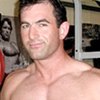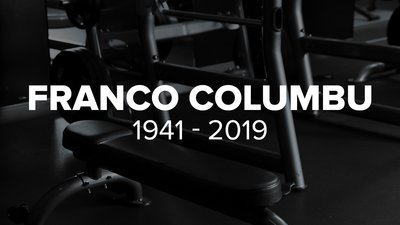Franco Columbu passed away on August 30, 2019, while swimming off the coast of Sardinia, Italy. He was 78 years old. He is survived by his wife, Deborah, and daughter, Maria.
He was famed among fitness and bodybuilding enthusiasts for his prodigious strength, numerous bodybuilding accolades, including two Mr. Olympia titles, and his incredible determination to succeed. But to those who knew him best, Franco will always be revered for his generosity of spirit and knowledge. Countless people benefitted from his remarkable perspective and were inspired by his unwavering perseverance and willingness to face down any physical challenge.
Let's take a moment to remember the man, what he accomplished, and what he meant to the fitness world.
A Legacy, and a Friendship, Forged in Iron
In videos and photos from bodybuilding's golden age, Franco immediately stands out for his thickly muscled physique—made even thicker by his height of just 5-foot-5. But in the gym, he was also legendary for his ability to routinely hoist unthinkable weights as if they were made of Styrofoam. He prided himself on being "the world's strongest bodybuilder," a throwback to the time when the two were considered equal components of the perfect body.
But his physicality wasn't just created in the gym. Well before his physique and feats of strength would wow the masses, Franco's humble beginnings saw him working as a shepherd in the hills surrounding his hometown of Ollolai, Sardinia. As a physically active young man, he parlayed his boundless energy into a successful career as a boxer, and then an Olympic weightlifter—molding the requisite strength and size for powerlifting and, ultimately, bodybuilding. He also trained as a bricklayer, gaining masonry skills that he would put to good use when he moved to Munich, Germany, and later in Los Angeles, California.
While Franco was accomplished in his own right, few of us think of him without also thinking of the enduring friendship he shared with fellow iron luminary Arnold. In 2016, the pair co-starred in a short documentary about their then 51-year-old friendship that has become essential viewing in the wake of Franco's passing.
Bodybuilding's most celebrated immigrants began their respective careers with little more than a dream to make it big in America. They shared an early passion for lifting heavy iron that led to a chance meeting at a bodybuilding competition in Munich in 1965. At that time, Arnold was a rising star in bodybuilding and was soon to be a multi-Mr. Universe winner. Franco, on the other hand, was well on his way to becoming one of the most formidable powerlifters of his day. They became fast friends, despite neither having a mastery of English. Both eventually made their way to California—Arnold in '68 and Franco in '69—with the sponsorship of publishing magnate Joe Weider, who played a highly influential role in their respective career trajectories. In Santa Monica, he and Arnold Schwarzenegger founded the "European Brick Works" to help support their early bodybuilding endeavors. In 2012, Arnold led a Bodybuilding.com film crew through his and Franco's old stomping grounds and shared his recollections of that time.
Upon arriving in the states, Franco also quickly got to work refining the raw materials that would ultimately comprise one of the most recognizable physiques ever to have graced a bodybuilding stage. And yet, Franco's genetics weren't ideal for the sport. His height made him sometimes appear blocky in comparison with taller competitors. His biceps were relatively short, and his legs, strong as they were, didn't always have the size to match his incredible upper body. But he more than held his own on the bodybuilding stage, fiercely challenging—and in all but a few cases beating—the greats of his era.
How did he do it? Through superior muscle density—a byproduct of his strength-focused work—his unbelievably shredded conditioning, and his powerful posing. He mastered all three in the hardcore environs of the original Venice Gold's Gym, among his iron brethren of bodybuilding's golden age. Franco recalled what made the gym so special in a 2018 interview with Muscular Development.
As captured in the critically acclaimed documentary "Pumping Iron," Gold's was no fancy gym, but what it lacked in redundant exercise machinery and cortisol-inducing cardio equipment it more than made up for in the very thing needed to transform average physiques into Olympia-worthy powerhouses: heavy free weights and benches and racks specifically reinforced for bone-crunching poundage. Although featured prominently in the film, Franco himself didn't go head-to-head against the giants Schwarzenegger, Ferrigno, and Nubret in the 1975 Olympia that was the main focus of "Pumping Iron." Instead, he won the under 200-pounds weight class. But the following year, he was named overall winner.
Gold's was heavily populated with the strongest and most impressively developed bodybuilders of the '60s and '70s, but none could outlift Franco. When training for size, he would still deadlift over 600 pounds for reps, do the same with 500 pounds in squats, and rep away on the bench press with a staggering 450-plus pounds, all at a comparatively meager body weight of around 185 pounds and with zero assistive gear. He was simply a phenom of the lifting world, and was later recognized as such when he was given the 2009 Arnold Classic Lifetime Achievement Award.
Though known mostly for his bodybuilding prowess, Franco was equally impressive on the competitive powerlifting circuit, officially bench pressing 525 pounds, squatting 655 pounds, and deadlifting 750 pounds. Franco's strength feats were by no means limited to the lifting platform. As immortalized in "Pumping Iron," he would inflate hot water bottles with lung power alone, a feat that required a staggering 600 pounds of pressure.
Not satisfied with being a national lifting legend, Franco also contested the World's Strongest Man event in 1977, alongside a diverse slate of strength legends including Ferrigno, as well as elite athletes from powerlifting, football, and track and field. Less than a year after winning Mr. Olympia, he finished a respectable fifth in the classic strongman competition, even after grotesquely dislocating his left knee while running downhill with an oversized refrigerator on his back—an injury that took three years of extensive rehab to recover from. Indeed, even considering his amazing strength feats and bodybuilding accomplishments, the truest testament to Franco's will and determination to succeed was perhaps the calm fortitude he displayed following his World's Strongest Man injury. (But be warned: The injury is awful to watch.)
Returning to Form
Despite the rigors of full-time bodybuilding preparation and his other physical pursuits, Franco put himself through college and graduated from chiropractic school in 1977, earning a Doctor of Chiropractic degree from Cleveland Chiropractic College of Los Angeles. He maintained a private chiropractic practice in Los Angeles up until his death. In 2006, he was appointed to the California Board of Chiropractic Examiners, and in a press release he gave at the time, Franco urged those suffering from injuries to get back to training as soon as possible—contrary to the then-current medical view to avoid all activity.
True to that statement, Franco did not let his devastating injury sideline him for long. He continued to do whatever he could in the gym to stay as fit and as muscular as possible. When he announced his decision to enter the 1981 Mr. Olympia contest, three years after his injury, many thought him delusional. But the mind of a champion will always prevail, and Franco was never known to let a challenge go unanswered. Disregarding the doctors who had told him his bodybuilding career was over and that he might never walk properly again, Franco got to work.
At first, he employed his own unique form of therapy, which initially consisted of walking up flights of stairs—sideways, backward, and forward. By 1980, he had regained some of his size and strength, but was still far from Olympia-ready. In 1981, he began filming for Conan the Barbarian in Spain but reinjured his left knee jumping off a rock. Undaunted, he continued his Olympia quest and, instead of bowing out, redoubled his training efforts.
In one of the biggest comeback stories in sporting history, Franco made it to the Olympia stage and fought it out against one the most impressive line-ups of all time, including Chris Dickerson and Tom Platz at their competitive peaks. And though he was pushed hard by a formidable field of bodybuilding greats, Franco ultimately won his second Sandow trophy.
Franco's amazing 1981 comeback says more about his will to endure and overcome than any other single achievement in his remarkable career. Whatever the obstacle, he simply never backed down. The challenges he overcame—from unlikely Olympia winner to self-made success story—show what can be achieved with sheer determination and grit, especially when they go hand in hand with a passion for hard training.
He will forever be remembered for his impact on bodybuilding, as well as the larger strength and fitness culture. RIP Franco Columbu, the Sardinian Samson.



